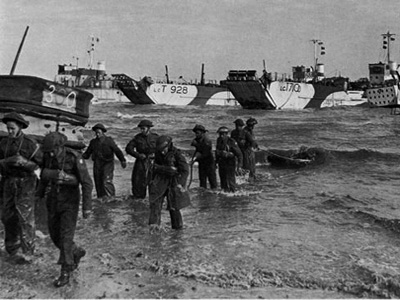D-Day Landings Part 3: Ouistreham Harbour, Riva Bella Casino and German Battery Observation tower
The French Commando Kieffer attempts to liberate Ouistreham
Ouistreham was a town situated just behind Riva Bella on the Normandy coast; close to the mouth of the River Orne and the Caen Canal. The area was strongly defended in 1944.
Historical background: 177 Frenchmen of the 1st Batallion of Fusiliers Marins Commandos landed there on 6 June 1944. The French under Commandant Kieffer were integrated into the N°4 British Royal Marine Commandos. They were granted the honour to set foot on Normandy soil in the first wave. The Commandos left about forty casualties on the beach and moved inland. Commandant Kieffer was wounded but went on with his troops.

Troop 1 suffered heavy losses in front of the casino strong-point. They eventually obtained support of a tank of the 13/18th Hussars of the 27th Armoured Brigade. The German blockhouse was neutralized and Ouistreham was liberated at the end of the morning. The Germans in the Artillery Observation tower next door survived completely surrounded and barricaded in for 3 days before surrendering to a platoon of Royal Engineers. Ouistreham was a small coastal harbour, but none the less useful to the Allies, as it was the gateway to the road to Caen, and the Orne river and canal.
Ouistreham harbour on the morning of 6 June 1944. Defended by a garrison of 716.er Inf. Div Germans, an HMG pillbox, twin 20mm guns on the harbour wall. A Quad Vierling AA gun was provided to protect against air attack. When the Germans saw the allied invasion force on the horizon a HMG on a tripod was also brought up and mounted on the harbour wall outside the harbour master's office and the water tank. The exposed fuel dump was particularly vulnerable to attack.
Our Alternate Battle:
Allied attack goes first. Preliminary bombardment spared the harbour, and concentrated on the Merville battery further up the coast and inland from OPuistreham. The commandos decided to split their forces, and attempt a sea-borne landing and assault on the harbour with half their force, while the balance landed in the second wave on Lion-sur-Mer beach, and attacked the Casino Riva Bella and the Artillery Bunker-tower there. Keiffer commanded that assault himself. The battle is descibed in the preceeding post.
Unlike the real battle, where Kieffer was only wounded, he was killed outright during the assault, and the Sherman tank reinforcements did not have any significant effect on the entrenched defenders. This had a serious knock-on effect for the Commando commanders, as half their forces were trapped on the beach at Lion-sur-Mer, and could not out-flank the German defenders as they had planned.
Wild Cards: Both generals rolled +1 on their reinforcement rolls.
Well before dawn allied bombers and transporters droned overhead, laden with Allied Airborne troops, on their way to the bridges over the Orne river and canal. The commando's huddled against the sea spray in their landing craft. A number of them slipped quietly into their cockleshell canoes, and started paddling towards the harbour, a dark silhoette ahead of them. Searchlights swept back and forth across the harbour approaches. The plan was to capture the harbour and link up with the Paratroopers who were dropping down behind enemy lines.
photo Roly Hermans
A RAF rescue launch dropped a number of the advance party near the harbour entrance. They slipped silently onto the shore under the cover of darkness. The sappers set about cutting through the barbed wire defenses. Then the probing Nazi searchlights found them...
A siren wailed, and simultaneously the German MG gunners opened fire, a sound almost like canvas ripping, but far more deadly: MG 42's firing! The commando's hit the deck in an attempt to make themselves as small as possible. The element of surprise was lost. Even though the Germans had started pinned down, the platoon that had started making the assault was in serious trouble.
Turn 1: The platoons of Commandos that have successfully landed start attacking the pill-box and 20mm gun emplacements. The German defenses are well thought out, and the commandos are caught in a murderous cross-fire. Rank after rank fall to the Heer machine gunners, specifically picking out command platoons with unerring accuracy. (Or shall I say lucky rolls) The commando officers appeared to be particularly suicidal on the day. Commandos do not avail of the British bulldog rule, but can act independent teams. Small consolation. Not a single German unit failed their pinning test, and the Commando forces took heavy casualties. Only a single platoon was left standing by the end of the German 1st round.
(another Roly photo)
View of the harbour with defenses, the Orne river to the right and the Canal to the left. In the distance a Horsa glider and the Canal bridge, fated eventually to become known for ever as "Pegasus bridge+, after the emblem of the 6th Airborne. German reinforcements are making their way to the harbour at left. Barely visible at the far left is the Merville battery.













